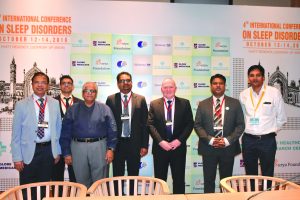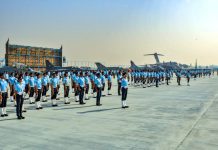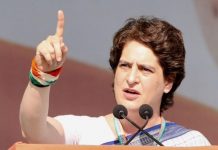 Our Constitution guarantees right to life and liberty to every person whosoever resides in Indian subcontinent. This precious fundamental right has been magnified and decorated with other inextricably blend ancillary rights such as humane, healthy conditions of living including right to sound sleep. Despite this constitutional philosophy and mandate to achieve goals set therein our people spend on third of their precious life in sleep even during working hours. Entire country is suffering from disorders of sleep but policy makers have not given a serious thought to this grave menace likely to take a shape of epidemic causing a huge loss to productivity in the south-eastern region of the world.
Our Constitution guarantees right to life and liberty to every person whosoever resides in Indian subcontinent. This precious fundamental right has been magnified and decorated with other inextricably blend ancillary rights such as humane, healthy conditions of living including right to sound sleep. Despite this constitutional philosophy and mandate to achieve goals set therein our people spend on third of their precious life in sleep even during working hours. Entire country is suffering from disorders of sleep but policy makers have not given a serious thought to this grave menace likely to take a shape of epidemic causing a huge loss to productivity in the south-eastern region of the world.
Insomnia is the most common sleep disorder, with ‘some insomnia problems over the past year’ reported by 30 per cent of adults, and chronic insomnia by 10 per cent.Prevalence of obstructive sleep apnoea, characterized by respiratory difficulties during sleep, is also high with estimates of 9–21 per cent in women and 24–31 per cent in men. Problem in India multiplied many times following the use of electronic devices and smart phone addiction prevalent in even the small kids making them vulnerable to sleep disorders. Blue light screens, i-phones, electronic gadgets not only impaired vision but stop sleep. Most important is when you eat. Undue work pressure and unrealistic targets of employment conditions, without proper sound sleep of minimum eight hours putting them at high risk, not only to sleep disorders but also various serious syndromes such as cardiovascular complications including stroke, Hypertension, Ischemic Heart disease, poor diabetes and Blood Pressure Control. It has enhanced the risk of vehicular and industrial accidents, with never ending trails of untimely deaths.
This unequivocal anxiety of experts emerged at 4th International conference of South-East Asian Academy of Sleep Medicine (ICSD-2018) held in Lucknow on October 13-14, 2018, where more than 500 Physicians and Chest Physicians, Neurologist, Psychiatrist, Dentist, Pediatricians and ENT surgeons participated in deliberations. Director of AIIMS Delhi, Prof Dr Randeep Guleria inaugurated the conference with the imminent presence of Prof David White (Harvard), Dr Meeta Singh, Ms Toni, Ms Lata Casturi (USA), Dr. Milind Sovani (UK), Dr. David Cunnington, Dr SSK Heranganahally (Australia), Dr Mahesh Babu (Singapore), Dr. Farhan Shah (Sweden), Dr. Anoria (Sri Lanka), Dr. Ramesh Chokhani and Dr. Milesh Sajapati (Nepal).
Medical disorders relating to sleep are not new but its diagnostics and treatment in India is just in its infancy stage as no priority is accorded to this grave concern which impaired quality of human life as insufficient sleep led to fatigue and sleepiness during working hours and sometimes even speakers on the dais seen taking nap during important meetings causing huge embarrassment to audience and dignitary himself.
Sleep is necessary but it functions, Physiology and Pathophysiology have been envisioned with the explosion of knowledge. Its research opened the doors to the field of sleep medicine as we know today. It has achieved incredible advancements in research and clinical experiences and sleep medicine education. Eminent International and National faculty on this subject assembled to interact about advancements in the field. Internationally, sleep disorders are classified in six major categories: Insomnia, Sleep related breathing disorders, Hypersomnias, Circadian rhythm sleep disorder, Parasomnia, Obstructive Sleep Apnea Syndromes (ADULT & pediatric), Restless Legs Syndrome etc.
In his inaugural address, Director AIIMS Delhi, Dr Guleria said that attempts to medicinally induce sufficient amounts of sleep have occurred since the advent of the medical arts, but the health implications of failing to maintain a correct balance of sleep/wake has only recently become widely appreciated both in the medical arena and among the general public. Inappropriate amounts of sleep have been linked to cognitive impairment, immune suppression and metabolic changes. Currently approved treatments for insomnia and excessive sleepiness have suboptimal risk: benefit ratios; thus, opportunities exist for improved beneficial approaches in the treatment of sleep/wake disorders.
Prof. David White (Harvard Medical School), President of the American Academy of Sleep Medicine, Chairing the Task Force to write the research plan addressing sleep and its disorders for the National Institutes of Health who has been recognised for his principle research interest for the pathophysiology of disorders of breathing during sleep about which he has published over 200 original papers. Prof. David, who is an authority in the field, told “Tehelka” that in USA some medicines are under trial those may remove various equipment of respiratory support. He found in one of his studies that the pattern in children is no different than the adults as they suffer same and similar types of ailment. Studying the way to sleep of 24000 kids snoring was most common among them.
Dr SSK Heranganahally from Australia President SEAASM Said 10 to 15 per cent of Total road accidents are due to sleepiness or driver fatigue. Furthermore by 2020 the number of people killed in motor vehicle crashes is expected to double to 2.3 million deaths worldwide, of which approximately 2.3 to 3.45 lacs will be due to sleepiness or fatigue.
Dr. David Cunnington from Australia said “Insomnia is the most common sleep disorder, with some insomnia problems near the past year reported by 30 per cent of adults.
Dr Mahesh Babu from Singapore General Hospital Singapore said, “One to 6 per cent of general pediatric population is suffering from insomnia. It is noticed that up to 25 per cent of children with severe sleep problem in infancy with later quality for a diagnosis of attention deficit hyperactivity disorders. Various sleep problems in pediatric age group like enuresis, sleep terror etc. are quite common but poorly addressed.”
“In India the situation has taken an alarming turn as 93 per cent of its population was found to be sleep deprived but only 2 per cent Indian discuss and share their sleep issues with physicians. Unfortunately no adequate training and counseling facilities are available for this huge population of the South-East Asian countries, to overcome such a stressful situation,” said Dr. B.P. Singh, a Respiratory Medicine professional in Lucknow and organizing secretary of the conference.
“Prevalence of Obstructive Sleep apnea, characterized by respiratory insufficiency during sleep is also high with estimates of 9-21 per cent in women and 24 to 31 per cent in Men. USA is associated with cardiovascular event like stroke, HT, ischemic heart disease, poor diabetes and BP control etc. Risk of Vehicular and industrial accidents, with increased risk of death,” he added.
Dr Pratibha Dogra from Artemis Hospital Gurgaon said, “A decline in sleep duration of up to 18 units per night over the past 30 years complains of sleeping problems has increased substantially over the same period with short sleep less than 6hrs/ night in full time worker becoming more prevalent. As you know this alone doubles the risk of heart attack, apart from other undesirable consequences.”
Dr HJ Singh from Jalandhar Punjab said It has been estimated that 40 per cent of fatal motor-vehicle crashes in Punjab are due to sleepiness or driver fatigue. Prof Arvind Tripathi from Saraswati Dental College Lucknow said Sleep disorders remain poorly identified in this part of world. It needs awareness in this field to more number of involved clinicians and populations.
Obstructive sleep apnea
Obstructive sleep apnea (OSA)/hypopnea syndrome (OSAHS) is an important and more common public health problem with increasing incidence. The main complaint of OSAHS patients is daytime sleepiness and the Epworth Sleepiness Scale (ESS) used for evaluation of disease severity. Study suggests that 648 patients with complaining of snoring and apnea were evaluated by Polysomonography and anthropometric measurements. It was found in the study that AHI is not enough for predicting DS; anthropometric measurements, apnea/hypopnea index and nocturnal hypoxemia should be evaluated.
In 2014, more than 1.9 billion adults aged 18 years and older were overweight. Of these over 600 million adults were obese. Overall, about 13 per cent of the world’s adult population (11 per cent of men and 15 per cent of women) was obese in 2014. In 2014, 39 per cent of adults aged 18 years and over (38 per cent of men and 40 per cent of women) were overweight. It has been suggested that with aging there is a preferential deposition of fat around the pharynx that is independent of systemic fat and deterioration of genioglossus negative pressure reflex which is largely responsible for this trend.
Community-based epidemiological studies from several parts of India have estimated that the prevalence of OSAS is 2.4 per cent to 4.96 per cent in men and 1 per cent to 2 per cent in women. This is similar to the prevalence of OSAS in the rest of the world where it has been reported to be 4 per cent in men and 2 per cent in women.
The majority of general public and primary care physicians are still unaware of OSA. In a study done in USA, nearly 93 per cent of women and 82 per cent of men with moderate severe OSAS are never diagnosed. In OSA, repetitive collapse of the upper airway occurs that leads to snoring, frequent episodes of sleep interruption, hypoxemia (abnormally low level of oxygen in the blood), hypercarbia (excess of carbon-dioxide), swings in intrathoracic pressure (the pressure within the pleural cavity) and increased sympathetic activity.
The co-occurrence of both Chronic Obstructive Pulmonary Disease (COPD) and OSA in the same individual is termed as overlap syndrome. Both are common diseases affecting adult population over 40 years of age.
Pediatric Insomnia is grave threat to future of kids. Prevalence estimated at 1 — 6 per cent in general pediatric population. A recent study of 46 children (5-16 y/o) found that 50 per cent of those presenting to a pediatric sleep center for insomnia had a preexisting psych diagnosis and the remaining 50 per cent had elevated psych impairment scores on psychometric measures and diagnostic interview. The boys of 3-5 age groups who are induced to night terrors games, 25 percent among them, mainly boys, may be found to suffer some type of sleep problem at some point during childhood. Complaints range from bedtime resistance and anxiety to primary sleep disorders, such as OSA and narcolepsy (a long-term neurological disorder that involves a decreased ability to regulate sleep-wake cycles). Research is remarkably consistent, with parents reporting 50 per cent of preschool children, 30 per cent of school aged children, and 40 per cent of adolescents as having sleep difficulties.
South East Asian Academy of Sleep Medicine, a pioneering body working for public awareness about sleep disorders, has undertaken a herculean task of conducting International Conference on various aspects of sleep disorders at Lucknow with the collaboration with Surya Foundation, Midland Healthcare and Globe Medicare at Lucknow to provide newer developments and knowledge of international researches in this field.
letters@tehelka.com














